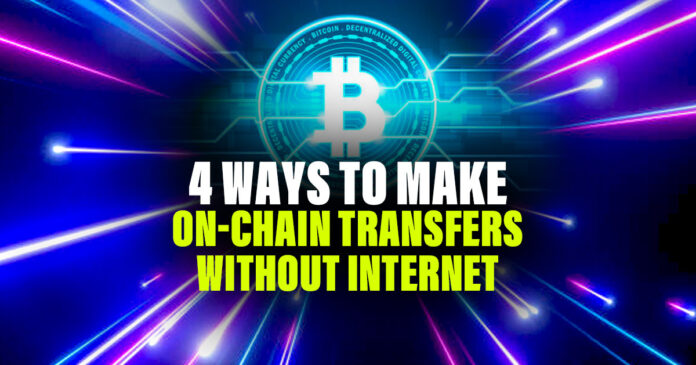One challenge that still exists is the reliance on the internet to make on-chain transfers. In this article, we’ll explore various methods that enable individuals to perform on-chain transactions without the need for an internet connection.
These methods offer practical solutions for scenarios where internet access is limited or unavailable.
No Internet Connection Doesn't Mean No Web3 Economy.
Here's your action plan on how to make on-chain transfers in case of an apocalypse ↓
#1 Data Broadcasting via Radio
Blockchain transactions can be broadcast via radio waves. By translating transaction data into radio… pic.twitter.com/IvnLR5LQ0J
— Stacy Muur (@stacy_muur) October 4, 2023
Method 1: SMS-Based Transactions
One of the most accessible ways to perform on-chain transfers without Internet access is through SMS-based transactions. This method utilizes Short Message Service (SMS) technology to broadcast transactions to the blockchain. Here’s how it works:
- Wallet Setup: You’ll need a cryptocurrency wallet that supports SMS-based transactions. Services like CoinText and Coinapult offer such wallets. Create an account and link your phone number to it.
- Transaction Initiation: To initiate a transaction, you send a specific SMS command to the wallet service. This command typically includes the recipient’s wallet address, the amount you wish to send, and a secure PIN or verification code.
- Confirmation: After receiving your SMS, the wallet service processes the transaction and sends you a confirmation SMS. You’ll need to enter your PIN or verification code to confirm the transaction.
- Blockchain Recording: The wallet service then broadcasts the transaction to the blockchain, where it is recorded on-chain.
For example, you can use Samourai’s wallet and make BTC transactions without the internet.
We've been hard at work building out full offline mode for Samourai Wallet. The next few updates will enable many new options such as offline broadcasting via SMS or @gotenna mesh network. Roll your own always offline cold storage with your unused android anyone? 👌 pic.twitter.com/A73unyWOMa
— Samourai Wallet (@SamouraiWallet) July 4, 2018
Method 2: Satellite Transactions
For users in remote areas or during internet outages, satellite transactions offer a reliable and secure way to make on-chain transfers. Companies like Blockstream provide satellite-based services that enable users to interact with the Bitcoin blockchain via satellite signals. Here’s a brief overview:
- Hardware Setup: You’ll need a satellite receiver, a small dish, and a computer with the necessary software installed. Blockstream provides detailed instructions for setting up the hardware.
- Transaction Creation: Using the Blockstream software, you create your transaction offline, including the recipient’s address and the transaction amount.
- Broadcast via Satellite: When you’re ready to send the transaction, the satellite receiver broadcasts it to Blockstream’s network of satellites, which then relay the transaction to the Bitcoin network.
- Confirmation: Once the transaction is received by the Bitcoin network, it is confirmed and recorded on the blockchain.
Broadcasting Bitcoin with satellites could provide extra cover and accessibility in the event of widespread internet failurehttps://t.co/q8TLJciL7o
— Cointelegraph (@Cointelegraph) December 21, 2018
Method 3: QR Codes and Offline Wallets
QR codes and offline wallets provide another offline option for making on-chain transfers. This method allows users to prepare transactions offline and then broadcast them when they regain internet access. Here’s how it works:
- Wallet Setup: Start by creating an offline wallet or using a paper wallet generator. These wallets are generated and stored completely offline, minimizing security risks.
- Transaction Preparation: With your offline wallet, prepare the transaction details, including the recipient’s address and the transaction amount. The transaction data is typically represented as a QR code.
- QR Code Storage: Save the QR code containing the transaction data on a physical medium like paper or a USB drive. Keep this medium secure.
- Broadcast the Transaction: When you have internet access, use a wallet software that allows you to scan the QR code and broadcast the transaction to the blockchain.
🧵Thread – Did you know #Polkadot has a cold storage solution called #PolkadotVault?
📱 Turn your old smartphone into an air-gapped #wallet
⛓️ Add chain spec and metadata for parachains offline
🖋️ Sign transactions with QR codesNew Wiki page 👇https://t.co/xs3UXwa9HM
— Filippo Franchini | Web3 Foundation (@filippoweb3) May 19, 2023
Method 4: Mesh Networks
Mesh networks offer a decentralized approach to enable on-chain transactions without relying on traditional Internet infrastructure. In a mesh network, users connect directly to nearby devices, creating a network that can transmit data without internet access. Here’s how it can work:
- Mesh Network Setup: In areas with limited or no internet access, communities can set up local mesh networks using readily available hardware like smartphones, routers, or specialized mesh network devices.
- Offline Wallets: Users on the mesh network can utilize offline wallets to create and sign transactions without an internet connection.
- Local Nodes: Some mesh networks may have nodes equipped with internet connectivity. Users can relay their offline transactions to these nodes for broadcasting to the blockchain.
- Blockchain Broadcasting: The nodes with internet access can then broadcast the transactions to the blockchain, ensuring they are recorded on-chain.
Many people are working on Bitcoin payment resilience in worst case scenarios.
This paper explores how wallets should open channels to each other in local community Wifi/Bluetooth mesh so that payments still work despite internet disruption.https://t.co/Tlq4izinuj pic.twitter.com/0lElZ5BqAw
— Adam Mashrique (@sakak_musdom) May 1, 2023
Conclusion
In a world where Internet access is not ubiquitous, the ability to make on-chain cryptocurrency transfers without relying on the Internet is invaluable. Various methods, including SMS-based transactions, satellite technology, QR codes, and mesh networks, offer practical solutions for users seeking to engage with cryptocurrencies offline.
These methods enhance the accessibility and resilience of cryptocurrency transactions, making them suitable for a broader range of use cases, from remote areas with limited connectivity to disaster-stricken regions with disrupted internet access.
Disclaimer
The information discussed by Altcoin Buzz is not financial advice. This is for educational, entertainment, and informational purposes only. Any information or strategies are thoughts and opinions relevant to the accepted levels of risk tolerance of the writer/reviewers and their risk tolerance may be different than yours. We are not responsible for any losses that you may incur as a result of any investments directly or indirectly related to the information provided. Bitcoin and other cryptocurrencies are high-risk investments so please do your due diligence. Copyright Altcoin Buzz Pte Ltd.





























